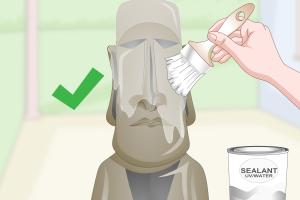Mastering the Art of Painting Concrete Statues: A Comprehensive Guide

-
Quick Links:
- Introduction
- Materials Needed
- Preparation Steps
- Painting Techniques
- Finishing Touches
- Case Studies
- Expert Insights
- Common Mistakes to Avoid
- FAQs
Introduction
Concrete statues can be beautiful and durable additions to gardens, patios, and homes. However, over time, they may lose their charm due to fading colors and weather damage. Painting concrete statues not only restores their original beauty but also allows for personalization to match your decor. In this comprehensive guide, we will delve into everything you need to know about painting concrete statues, including preparation, techniques, and finishing touches.Materials Needed
Before you start painting, gather the necessary materials. Here's a checklist to ensure you have everything you need:- Concrete statue
- Wire brush or sandpaper
- Cleaning solution (water and mild detergent)
- Rags or paper towels
- Primer (for concrete)
- Outdoor acrylic paint or concrete paint
- Sealant (optional for added protection)
- Paintbrushes (various sizes)
- Drop cloths or newspapers
Preparation Steps
Proper preparation is crucial for achieving a long-lasting finish. Follow these steps:1. Cleaning the Statue
Before painting, clean the statue thoroughly to remove dirt, grime, and any old paint. Use a wire brush or sandpaper to scrub the surface gently. Follow up with a cleaning solution made of water and mild detergent. Rinse well and let it dry completely.2. Repairing Damage
Inspect the statue for any cracks or chips. If you find any, fill them with a concrete repair compound. Allow the compound to cure as per the manufacturer's instructions.3. Priming the Surface
Applying a primer specifically designed for concrete can significantly improve paint adhesion. Use a paintbrush to apply a thin layer of primer and let it dry completely.Painting Techniques
Once your statue is prepped, it’s time to paint. Below are some popular techniques you can use:1. Traditional Brush Technique
Use a paintbrush to apply the paint evenly. This technique is ideal for detailed areas and is great for achieving an even coat.2. Spray Painting
Using a spray paint designed for outdoor use can provide a smooth and even finish. Ensure you work in a well-ventilated area and follow safety precautions.3. Sponge Painting
For a textured or mottled effect, use a sponge to apply paint in a dabbing motion. This technique is excellent for adding depth and interest.4. Stencil Painting
If you want to add designs or patterns, consider using stencils. Secure the stencil in place and use a brush or sponge to apply paint over it.Finishing Touches
After the paint has dried, consider applying a sealant to protect your work from the elements. Here are a few options:- Clear acrylic sealant: Provides a glossy finish and protects against UV rays.
- Matte sealant: Ideal for a natural look without shine.
Case Studies
To further illustrate the impact of painting concrete statues, let's look at a few case studies:Case Study 1: Restoring a Garden Gnome
A homeowner restored an old garden gnome that had faded in color over the years. By cleaning, priming, and applying bright acrylic colors, the gnome was transformed into a vibrant focal point in the garden.Case Study 2: Customizing a Bird Bath
Another individual opted to customize a plain concrete bird bath with a mosaic style. Using stencils and a variety of colors, they created a unique piece that attracted local birds and delighted visitors.Expert Insights
According to professional artists and home improvement experts, the key to successful painting lies in preparation and patience. "Rushing through the cleaning and priming stages can lead to paint peeling or chipping," says John Doe, a local artist specializing in outdoor decor.Common Mistakes to Avoid
Here are some common pitfalls to avoid when painting concrete statues:- Skipping the cleaning process
- Not using primer
- Overloading the paintbrush
- Painting in direct sunlight
FAQs
1. Can I use regular paint on concrete statues?
No, it’s recommended to use outdoor acrylic paint or paint specifically formulated for concrete to ensure durability.
2. How long does the paint take to dry?
Drying time varies based on the type of paint used and environmental conditions, but generally, it takes 1-2 hours to dry to the touch and 24 hours for a full cure.
3. Do I need to seal the painted statue?
While not mandatory, sealing the statue enhances protection against weathering and extends the life of your paint job.
4. How can I remove old paint from a concrete statue?
Use a wire brush or sandpaper to gently remove the old paint. For stubborn areas, a paint stripper designed for concrete may be effective.
5. Can I paint over a previously painted statue?
Yes, but it’s crucial to clean and possibly sand down the surface to ensure good adhesion for the new paint.
6. What is the best time of year to paint concrete statues?
Spring and fall are ideal for painting, as temperatures are milder and humidity levels are lower.
7. How long will the paint last on a concrete statue?
With proper preparation and sealing, painted concrete statues can last for several years before needing a touch-up.
8. Is it safe to paint concrete statues indoors?
While it is safe, ensure adequate ventilation as paint fumes can be harmful in confined spaces.
9. Can I use spray paint on concrete statues?
Yes, spray paint can be used effectively on concrete statues. Just make sure it’s designed for outdoor use.
10. How can I create a textured finish on my statue?
You can achieve a textured finish by using a sponge or a stippling brush during the painting process.
Random Reads